|
The Illustrated Weekly Newspapers Including
Gleason's Pictorial Drawing-Room and Others
The Illustrated Weeklies. The 1840s~50s saw the rapid growth in popularity of the illustrated weekly newspapers. There are several familiar names which include, Harperís Weekly, Frank Leslieís Illustrated News, Gleasonís Pictorial Drawing-Room Companion, Ballou's Pictorial Drawing-Room Companion, the New York Illustrated News and, perhaps the most popular and innovative, the Illustrated London News. These publications followed a tested and proven formula of carefully combining elements of war, politics, art, science, travel and exploration, literature and the fine arts in each issue. The writings were heavily supplemented with illustrations. In the 1840s and 1850s, the illustrations were woodcut engravings. The weeklies tended to follow a formula of 16 pages per issue with approximately 16~32 illustrations per issue. The Christmas 1855 issue of the Illustrated London News was a ground breaking issue as it contained the first color pictures printed in an English newspaper. These color pictures in the Illustrated London News were printed on wood blocks using a process pioneered by George Leighton and represent a landmark in application of color printing process in the mass media setting. Ļ The illustrated weeklies often had articles of the Perry Expedition to Japan and Japan in general. This page will outline key articles that appeared during the 1850s and 1860s relating to the Perry Expedition and Japan.
Information on Gleason's. Gleasonís Pictorial Drawing-Room Companion was one of America's foremost illustrated newspaper. It covered all aspects of life both here and abroad. The paper began publication in 1851. As stated by Gleason's:
...the object of the paper is to present, in the most elegant and available form, a weekly literary melange of notable events of the day, its columns are devoted to original tales, sketches and poems, by the Best American authors, and the cream of the domestic and foreign news; the whole well spiced with wit and humor.
This illustrated newspaper really is a window into the past. The written and illustrated articles give one a glimpse of what life was like 150 years ago and the matters that were of concern and interest to the people of those days.
Maturin Ballou became the managing editor of the paper in 1854 and in 1855 he purchased the paper. The name was then changed to Ballou's Pictorial with the first issue in 1855 (January 6).
Physical Layout of Paper. The papers are large quarto in size, slightly smaller than 12" by 16." Each issue contains sixteen pages. The text is generally presented in column format (primarily three) with woodcut illustrations.
Illustrations.
- Woodcut Engravings (B/W).
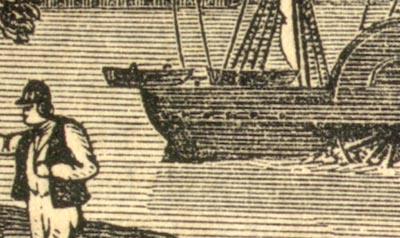
Details/Characteristics of Woodcut Engraving
Other forms of illustration were popular at this time (steel engravings and lithographs) but Gleason's only employed woodcut engravings. To see the characteristics of steel engravings and lithographs, click here.
- Size. Illustration size ranges from full page (FP) to centerfold (CF) to text illustrations (TI) that can approach full page size but generally are 1/4~1/2 page in size.
- General Comment. These really are pictorial/illustrated newspapers. I estimate that 25%-40% of the total page space of an issue is covered by the illustrations.
- Illustration with Color Added Later.
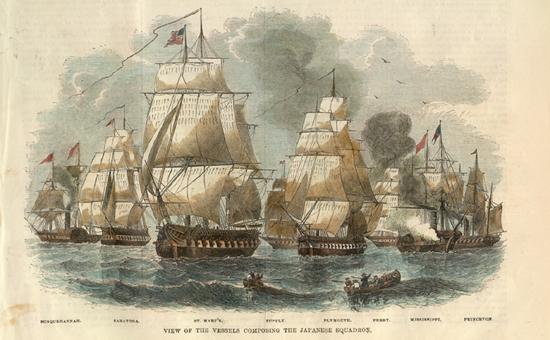
All the information I have reviewed indicates that the illustrations in Gleason's were all black in white. I find no evidence that Gleason's ever printed a color illustration as the Illustrated News of London first did in 1855. On occasion Gleason's illustrations are found with color added later. This was the an individual effort and was not present when the paper was issued.
Contents.
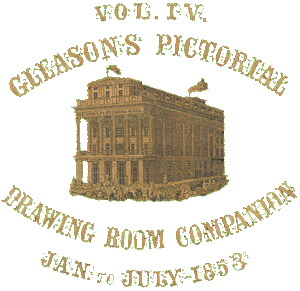 Gold Guilt Embossed Title
Front Cover, Bound Volume IV
Bound Volumes - Issues in Volume
Gleason's marketed bound semi-annual volumes. These volumes have cloth covers with embossed decorative designs and gold guilt titles and illustrations. The title page is an elaborate engraving. The bound volumes also contained an "Index to Miscellany" (for text articles) and an "Index to Illustrations" for articles with illustrations. In its advertising, Gleason's asserts that each bound volume contained nearly 1,000 engravings. The Gleason bound volume are small folio size (11 1/2 x 15 1/2 in - 29.5 x 39.5 cm). The issues were often bound privately or rebound later so you find the volumes in a wide variety of boards/formats.
Condition of Individual Issues.

 Most of the issues on the market were removed from the bound semi-annual volumes. Therefore, they often have evidence that they were separated from the spin. This includes small holes or short tears (between the stitch holes) where the units were stitched together. The area around the centerfold crease tends to have varying amounts of foxing and staining (see picture at right).
Most of the issues on the market were removed from the bound semi-annual volumes. Therefore, they often have evidence that they were separated from the spin. This includes small holes or short tears (between the stitch holes) where the units were stitched together. The area around the centerfold crease tends to have varying amounts of foxing and staining (see picture at right). The paper is a typical brownish color for material of this period. Foxing and staining are very common. While not always, there is sometimes evidence of a light horizontal fold, even for issues taken from bound volumes. Minor dog eared corners, small margin tears and light water stains in the margin are common and the norm in my experience.
Typical Paper Color and Condition
 The paper stock used for this newspaper seems to be a cut above that normally used at this time period. It is printed on rag paper and it tends to remain flexible over the years. While the pager does age it does not seem to become dark brown/tan and brittle like papers of this era made from lesser quality paper stock.
Articles Concerning Perry and the Japan Expedition.
Volume I.
- 51.05.14 -- (#4-64) US Steamer Mississippi also illustration of a ball aboard the Mississippi (back page), May 14, 1951, Volume I, No. 4, page 64.
- 51.11.29 -- (#31-492) Kossuth and Family on the Deck of the U.S. Steam Frigate Mississippi, at Marseilles, November 29, 1951, Volume I, No. 31, page 492.
Volume II.
Volume IV.
Volume V.
Volume VII.
- 54.08.05 -- Commodore Perry, August 5, 1854, Volume VII, No. 5, Whole No. 161, page 68.
- 54.??.?? -- Lieutenant Mathew Fontaine Maury, ? ?, 1854, large engraving (noted oceanographer who contributed to Narrative of the Perry Expedition - Volume 2).
Articles Concerning Japan but not the Perry Expedition.
Volume III.
Volume IV.
- 53.04.09 -- Japanese Customs and Ceremonies, April 9, 1853, Volume IV, No 15, whole number 93, page 233 (full page with two 1/3 page engravings - wedding & funeral.
- 53.04.09 -- Japan and the Japanese, April 9, 1853, Volume IV, No 15, whole number 93, page 238 (2/3 page text).
Mr. Gleason, with his wonted liberality, has made arrangements for pen and pencil chronicles of the progress of this expedition.... (Vol IV, No 15, page 233).
- 53.04.23 (#095-157) -- Throne of the Emperor at Yedo, April 23, 1853, Volume IV, No 17, whole number 95, page 257, front page illustrated article.
Volume V.
- 53.10.15 -- "Japanese Scenes, Fishing in Japan and View of Congoxuma," single page article with two illustrations, October 15, 1853, Volume V, No. 18, Whole No. 120, page 256.
- 53.12.03 -- "Saccai, Japan," December 3, 1853, Volume V, No 23, Whole No. 127, page 368.
Volume VI.
- 54.02.25 (#138) -- Scenes in Japan, illustrations include: Court Dress of Japan, View of Simoneski, Cloth Mill, Rural Scenery in Japan, Japanese Arms--Swords, Scimetars, etc & Weights and Measures of Japan. Two pages (5 illustrations) of text and illustrations. February 25, 1854.
- 54.06.10 (#153)-- The First Japan Expedition (Biddle's Failed Mission in 1849 a page 364), June 10, 1854.
- 54.06.24 (#155) -- Scenes in Japan, illustrations include: View of Tokaito, a Summer Residence in Japan, the Mountain Fudsi Jamma, Japan, Hawking and Hunting in Japan, June 24, 1854.
Volume VII.
- 54.07.08 (#157) -- Japan and the Japanese, I, by Rev Luther Farnham, July 8, 1854, page 14, non-illustrated article covering 2/3+ page.
- 54.07.15 (#158) -- Japan and the Japanese, II, by Rev Luther Farnham, July 15, 1854, page 30, continuation, non-illustrated article covering 2/3+ page.
- 54.07.22 (#159) -- Mount of Pleasures and Japanese Harbor (front page), July 22, 1854, page 33, front page illustrations with article.
- 54.07.22 (#159) -- Jeddo, Capital of Japan, illustrations include: A View of "Jeddo" the Capital of Japan and A view of a Dutch Factory at "Firato" and four drawings of Japanese court dress, July 22, 1854, pages 40-1 with article on both pages.
- 54.07.22 (#159) -- Japan and the Japanese, III, by Rev Luther Farnham, July 22, 1854, page 46, continuation, non-illustrated article covering full page.
- 54.07.29 (#160) -- Japan and the Japanese, IV, by Rev Luther Farnham, July 29, 1854, page 62, continuation, non-illustrated article covering full page.
- 54.08.05 (#161) -- Portrait of Commodore Perry of the Japan Expedition, August 5, 1854, page 68, with article.
- 54.08.05 (#161) -- Japan and the Japanese, V, by Rev Luther Farnham, August 5, 1854, page 78, continuation, non-illustrated article covering full page.
- 54.08.12 (#162) -- Japan and the Japanese, VI, by Rev Luther Farnham, August 12, 1854, page 94, continuation, non-illustrated article covering full page.
- 54.08.12 (#162) -- Oliver H Perry engraving and text with the Battle of Lake Erie in the War of 1812 (Commodore Matthew Perry's brother), page 94.
- 54.08.19 (#163) -- Japan and the Japanese, VII, by Rev Luther Farnham, August 19, 1854, page 110, continuation, non-illustrated article covering full page. This article discusses Loo Choo and the party given by the Regent for Commodore Perry. It has a quote, regarding the party, from an article written by a German with the expedition (Heine).
- 54.08.26 (#164) -- Japan and the Japanese, VIII, by Rev Luther Farnham, August 26, 1854, page 126, continuation, non-illustrated article covering full page.
- 54.09.02 (#165) -- Japan and the Japanese, IX, by Rev Luther Farnham, September 2, 1854, page 142, continuation, non-illustrated article covering full page.
- 54.09.09 (#166) -- Japan and the Japanese, X, by Rev Luther Farnham, September 9, 1854, page 158, continuation and conclusion, non-illustrated article covering full page.
- 54.09.16 (#167) -- Japanese Scenes, illustrations include: Wonoga Take, Japan, Country People of Japan, River Setagawa and Bridge Setabas, Japan, Japanese boats (3 illustrations) September 16, 1854, pages 168-9, a total of 6 major illustrations each covering 2 pages, with accompanying text.
Other Illustrated Articles Relating to Japan
Ballou's Pictorial Drawing-Room Companion:
- 55.01.06 ~ 55.06.30 -- Volume VIII. For details on this semi-annual bound volume, click here.
- 55.01.06 -- "Comprehensive Representation of all the Sailing Vessels and Steamships in the United States Navy" (2 page fold out illustration). The illustration shows several of the ships accompanying the Perry Expedition to Japan to include the Mississippi, the Susquehana, the Powhatan, the Saratoga, and the Macedonian. (pic here) - (Vol VIII, No. 1, Whole No. 183 at pages 8-9).
- 55.04.28 -- Scenes in Japan - Mountain Me Take, City of Simoneseki & Temple of Nishihongwanzi at Miako (Vol VIII, No. 17, Whole No. 199 at pages 260-1).
- 55.07.07 ~ 55.12.29 -- Volume IX. For details on this semi-annual bound volume, click here.
- 55.10.06 -- Testimonial to Commodore Perry (Vol IX, No. 14, Whole No. 222 at page 220).
- 55.11.17 -- Round the World - Japanese Funeral, Japanese Palanquin, Dinner on Board US Ship Powhatan) (Vol IX, No. 20, Whole No. 228 at page 312-3).
- 55.12.01 -- Whaling Scene on the Coast of Japan (Vol IX, No. 22, Whole No. 230 at page 340).
- 56.04.12 -- City and Bay of Nagasaki, Japan (back page)
- 56.08.20 -- ?? August 20, 1856.
- 56.05.30 -- Sumo Wrestling, Japan, May 30, 1857.
- 58.03.30 -- View of Jedo, Japan, March 20, 1858.
Harper's Weekly:
- 60.05.19 (#177-316) -- Our Japanese Visitors, 3 illustrations, May 19, 1860
- 60.06.28 (#182-389) -- The Japanese Embassy & Attendants and Tommy (Japan Embassy to US), June 28, 1860
- 94.12.29 (#1984-1232) -- Life in the Foreign Settlements of Japan, 1 full page of photo illustrations and an article, December 29, 1894
Frank Leslie's Illustrated Newspaper:
- 56.03.26 (#20) -- Loo Choo related article?
- 56.05.10 (#22) -- Loo Choo related article?
- 58.03.13 (#119) -- Commodore Matthew C. Perry, U.S.Navy Deceased, front page full age portrait of Perry, March 13, 1853, bound volume V.
New York Illustrated Newspaper??:
- 53.11.05 (Vol 2, #45) -- "Crater of Fudsi Jamma" and Perry Expedition
- 53.??.?? (Vol 2, #47) -- Sumo Wrestlers and Perry Expedition to Japan
- 53.??.?? (Vol ?, #??) -- Perry's Squadron arriving in Japan and Japanese horse race.
Illustrated London News:
- 50.10.03 -- Mode of Traveling in Loo Choo
- 51.03.08 -- Sketches in Loo Choo, 4 Okinawa illustrations
- 53.05.07 -- Portrait of Perry and Illustration of the Mississippi (2 different illustrations)
- 56.01.05 (#778) -- Earthquake in Japan (Sinking of Russian ship Diana in Shimoda harbor) at page 13, one illustration
- 56.01.26 (#781) -- Sketches in Japan (Scenes in Hokadate and Nagasaki) at pages 84-5, 8 illustrations
- 56.12.13 (#834) -- Characteristics of Japan - The United States Expedition (pages 590-1), three illustrations from the Official Narrative including the Crossing the Oho-E-Ga-Wa facsimile
- 57.01.03 (#838) -- The Folding Screen: A Japanese Tale (page 679-80), two illustrations
A typical large woodcut engraving from the TP
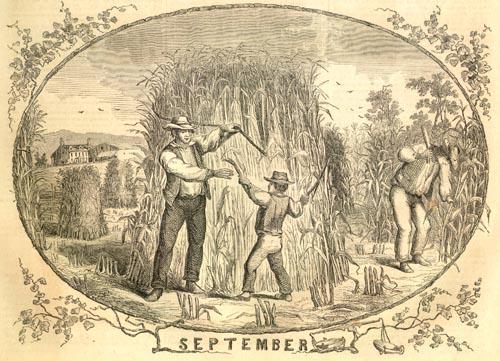
This subject is addressed in English Coloured Books by Martin Hardie, 1990 (First Published in 1906) as follows:
A notable landmark in the history of English illustration was the appearance of the special Christmas supplement to the Illustrated London News in 1855, containing the first examples of colour illustration in an English newspaper. The four plates--two after Sir John Gilbert and one after 'Phiz' and G. Thomas respectively-- were printed from wood blocks by George Leighton, of Red Lion Square. (page 283)
The book notes that from 1858 Leighton became the printer and publisher of the paper and the colour printing from wood blocks or wood blocks combined with metal, continued until the 1880s when the chromo-lithograph replaced that process.
|
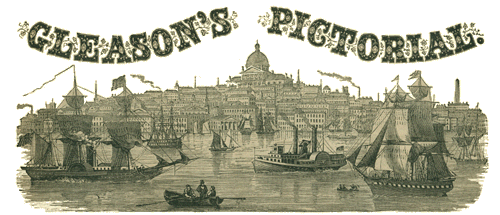

 Individual Issues of Gleanson's Pictorial For Sale
Individual Issues of Gleanson's Pictorial For Sale 
 Individual Issues of Gleanson's Pictorial For Sale
Individual Issues of Gleanson's Pictorial For Sale 